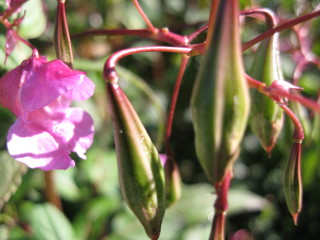Himalayan Balsam
River side invader
About
This attractive annual plant was introduced to Ireland from the Himalayas and has since become a very invasive weed. It is becoming more widespread and County Galway particularly in damp habitats such as river banks and wet grasslands.
How to recognise it?
Himalayan balsam is a tall plant (up to 3 m) with large pale pink to purplish trumpet shaped flowers from June to October. It has distinctive brown/green to reddish colour hexagonal hollow stems. Its leaves are dark green, lance shaped with serrated edges. Hanging seed pods which explode when touched.
Why is it a problem?
It spreads rapidly forming dense colonies which out compete native species. In the winter it dies back exposing bare soil vulnerable to erosion. This may lead to siltation of rivers and loss of spawning beds for fish or flooding. Himalayan balsam produces copious amounts of nectar and it may attract insects away from other plants thus reducing pollination of native wild flowers.
How does it spread?
The exploding seed pods of Himalayan balsam scatter for a distance of up to 7 metres. The seeds can be transported by wind or water. However, the seeds only remain viable in the soil for a year or two.
Legislation
Himalayan balsam is listed on the Third Schedule of the European Communities (Birds and Natural Habitats) Regulations, 2011 (S.I. No. 477 of 2011) which makes it an offence under Regulation 49 to plant, disperse, allow or cause to grow this plant in the Republic of Ireland.
Regulation 50 makes it an offence to import, buy, sell, breed, reproduce or propagate, advertise, offer or export for sale, publish a price list, transport or distribute any species on the Third schedule. (This regulation is not in effect pending Ministerial notice)
A licence may be obtained in certain circumstances to permit these activities.
What can you do?
- Report the location of the weed to Galway County Council (see below) or the National Biodiversity Data Centre http://www.biodiversityireland.ie/projects/invasive-species/submit-sightings/
- Inform landowners that have Himalayan balsam on their property.
- Do not dump plant cuttings or soil elsewhere
- Control: Use the most suitable method to remove the infestation from your property (see below).
Control
Manual Control
Pulling: Himalayan balsam is shallow rooted and can be easily pulled up. Pulled plants can be allowed to rot on site provided there are no seed heads. Wear gloves to protect hands.
Grazing: Where suitable, grazing by cattle or sheep from April right through the growing season can be effective. Continue grazing regime annually until no new growth occurs.
Cutting: Cut at ground level (below first node) using a scythe, strimmer or flail cutter before flowering in June.
Chemical Control
A glyphosate based weed killer approved for use near water can be used:
Weed wiper: Where the weed is growing among other vegetation
Foliar spray: Using knapsack sprayer with a long lance to treat dense stands. Note – on river banks that the area should be reseeded with suitable species soon after to stabilize the soil and suppress weed regrowth.
Please take care when using herbicides, and carefully consider your impacts on nearby land or waterways. Read the label carefully, and always use appropriate safety equipment.
Timing
Do not disturb Himalayan balsam if seed pods are present. Herbicide treatment for this weed is most effective in the spring, before flowering (April – mid June). It should take about 2 – 3 years of annual treatments to clear the infestation, after which you should perform annual checks to control any new seedlings growth.
Pesticide regulations
Further Information
Further Information about Himalayan balsam and other invasive species can be found at:
http://biodiversity.galwaycommunityheritage.org/
http://www.biodiversityireland.ie/projects/invasive-species/
http://invasivespeciesireland.com/
Contact Details
To report Himalayan balsam or other problem species, contact the Galway County Council
Phone: 091-509309
Email: invasivespecies@galway.ie















No Comments
Add a comment about this page